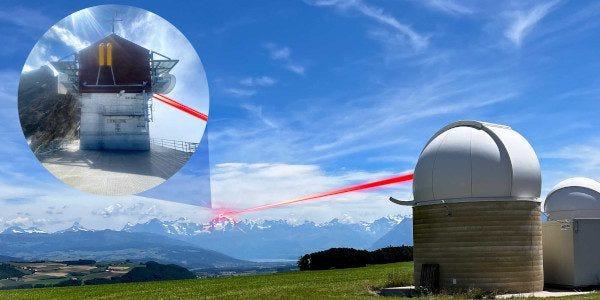Satellite Internet Backbone Enabled by Lasers Studied
Scientists at ETH Zurich are working on a satellite Internet backbone enabled by lasers, rather than using the thousands of miles of fiber optic cables that currently make up the system. As the first step of establishing this satellite Internet backbone, the ETH Zurich researchers have successfully demonstrated terabit optical data transmission through the air in a European Horizon 2020 project.
"Until now, only two options have been possible: connecting either large distances with small bandwidths of a few gigabits or short distances of a few meters with large bandwidths using free-space lasers.”
ETH Zurich Professor Jürg Leuthold
The test was conducted between the alpine mountain peak, Jungfraujoch, and the Swiss city of Bern. Although the laser system was not directly tested with an orbiting satellite, they accomplished high-data transmission over a free-space distance of about 33 miles. “For optical data transmission, our test route between the High Altitude Research Station on the Jungfraujoch and the Zimmerwald Observatory at the University of Bern is much more challenging than between a satellite and a ground station,” said Yannik Horst, the study’s lead author and a researcher at ETH Zurich’s Institute of Electromagnetic Fields headed by Professor Jürg Leuthold.
The laser beam travels through the dense atmosphere near the ground. In the process, many factors – diverse turbulence in the air over the high snow-covered mountains, the water surface of Lake Thun, the densely built-up Thun metropolitan area and the Aare plane – influence the movement of the light waves and consequently also the transmission of data. The shimmering of the air, triggered by thermal phenomena, disturbs the uniform movement of light and can be seen on hot summer days by the naked eye.
Laser Satellite Internet Backbone Improves Space-Based Internet
Currently, satellite Internet delivered by companies like Starlink transmit data between satellites and ground stations using radio technologies, which are considerably less powerful. Like a wireless local area network (WLAN) or mobile communications, such technologies operate in the microwave range of the spectrum and thus have wavelengths measuring several centimeters.
Laser optical systems, in contrast, operate in the near-infrared range with wavelengths of a few micrometers, which are about 10,000 times shorter. As a result, they can transport more information per unit of time.
For the first time in this satellite Internet backbone test, new robust light modulation formats were demonstrated. This enabled a huge increase in detection sensitivity and thus high data rates, even under the worst weather conditions or at low laser power. This increase is achieved by cleverly encoding the information bits in properties of the light wave such as amplitude, phase and polarization. “With our new 4D binary phase-shift keying, or BPSK, modulation format, an information bit can still be correctly detected at the receiver even with a very small number – about four – of light particles,” Horst said.
The results of the experiment were presented for the first time at the European Conference on Optical Communication (ECOC) in Basel. Leuthold says, “Our system represents a breakthrough. Until now, only two options have been possible: connecting either large distances with small bandwidths of a few gigabits or short distances of a few meters with large bandwidths using free-space lasers,” Leuthold said.
Moreover, the performance of 1 terabit per second was achieved with a single wavelength. In future practical applications, the system can be easily scaled up to 40 channels and thus to 40 terabits per second using standard technologies.
(Source: ETH Zurich news release. Images provided)




